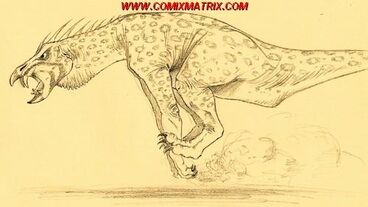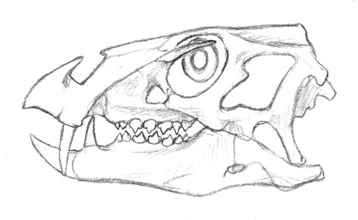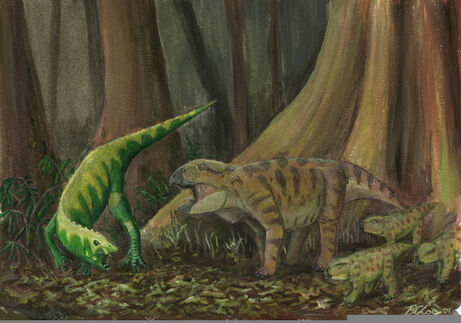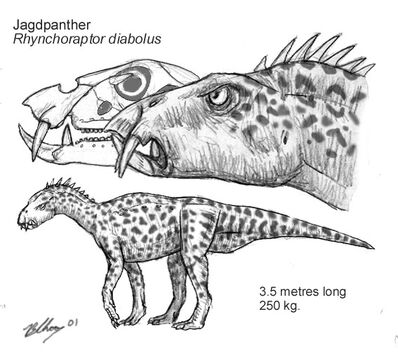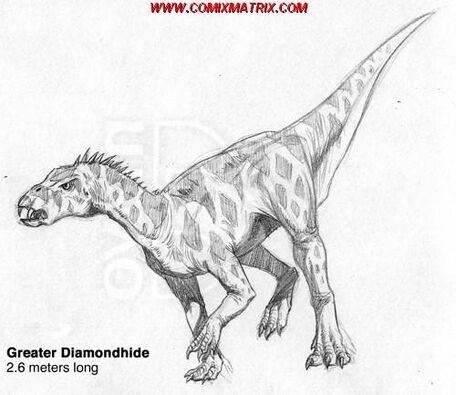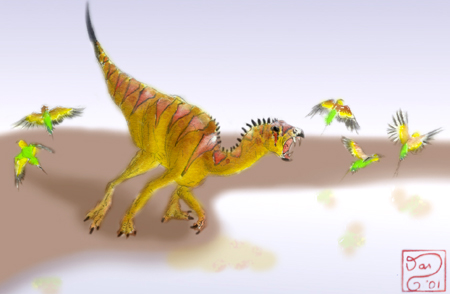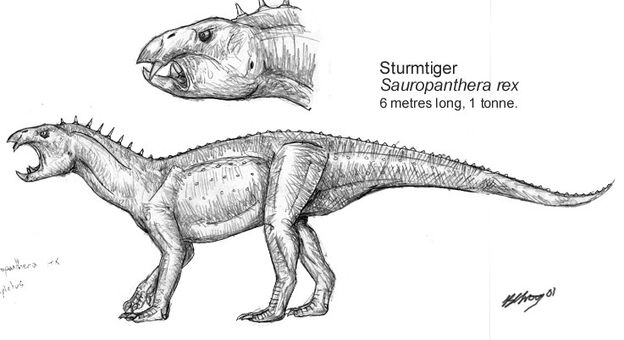Many aspects of the Spec-Australian biota are unique and bizarre, none more so than the 30 species of rhynchoraptors, carnivorous ornithopods that dominate the large predator guilds of this continent, their only major competition being flightless pterosaurs known as carnocursors. They are amongst the most highly specialized ornithischians in the world and are the first non-theropod big-game land predators to have evolved since at least the Late Triassic.
Rhynchoraptor ancestry can be traced to small, basal euornithopods of the same stock that produced the euclasaurs and viriosaurs. Many small, normally herbivorous ornithopods even today will often take insects and smaller vertebrate animals and in the Late Paleocene, one family became increasingly adapted for an omnivorous lifestyle. The poorly understood Eocene-Oligocene Extinction Event cleared out Australia's top predators (abelisaurids and deinonychosaurs). In the ensuing ecological vacuum, two dinosaurian lineages - the early rhynchoraptors, the ancestors of the cedunasaurs, and flightless pterosaurs all competed for supremacy in the large predator guilds. Despite the cedunasaurs producing some terrifying monsters, the most notable being the massive Pikodon maximus, they were unable to compete with the rhynchoraptors and the carnocursors, ending with the large forms dying out, leaving the two other groups to dominate the top predator niches. The cedunasaurs, meanwhile, have seen some success as smaller predators.
The skull of a rhynchoraptor immediately betrays both its predatory nature and its ornithopod heritage. The predentary bone has become a long, curved stabbing structure. The front pairs of teeth have become similarly adapted for stabbing. The upper pair (the sole remaining premaxillary teeth) slide around the narrow predentary when the mouth is closed whilst the bottom pair (the first two dentary teeth) slot into a pit just behind the premaxilla.
Unlike theropods, the rhynchoraptors are precision biters using their specially adapted dentition to crush or pierce the jugular or some other vital structure on their victim. The foreclaws have become long and curved to aid in securing the victim. Smaller rhychoraptors run on two legs whilst the larger species are facultative quadrupeds. An odd feature: the smaller forms are primarily egg-layers whilst the large species are viviparous.
Recent DNA analyses reveal that some purported species are in fact complexes of similar forms, in particular, so-called Papuan subspecies of Australian diamondbacks and jagdpanthers are separate species in their own right. Additionally recent surveys of Melanesia have uncovered many previously unknown forms. In fact, the rhynchoraptor stranglehold on the predatory guilds on these islands is even more complete than in Australia, although diversity tapers off west of Wallace's line.
DASPLETODONTIDAE[]
Anklebiter (Daspletodon nanus)[]
With their bipedal postures and protruding fangs, daspletodontids, the aptly-named anklebiters, bear a strong (if entirely superficial) resemblance to the ancient heterodontosaurs. These little predators are, however, rynchoraptors, only distantly related to the heterodontosaurs
Uncommon on mainland Australia, anklebiters are the dominant (often the only) predators of the Melanesian islands. Many species are found on Papua as well (although there they play second fiddle to their larger cousins). The smallest rhynchoraptor, the anklebiter (Daspletodon nanus), is an agile hunter of mammals and small dinosaurs on the forest floor. Understandably, this form was initially described as a possible heterodontosaur when it was first discovered.
RHYNCHORAPTORIDAE[]
All large rhynchoraptors are ambush predators that subdue their prey with their forelimbs before dealing a lethal precision bite. They started as small bipeds (ie. anklebiter) - however as they began to target larger, more dangerous prey their forelimbs became increasingly large and well-muscled while their frontal osteology became robust and reinforced to hand the rough-and-tumble activity (they are a lot more solidly built than a comparable sized theropod). Eventually the larger rhynchoraptors (formally Rhynchoraptoridae) were too front heavy for practical bipedalism.
Jagdpanther (Rhynchoraptor diabolus)[]
This majestic predator, the jagdpanther (Rhynchoraptor diabolus), is found throughout the continent from semi-desert to rainforest-edge. It is largely nocturnal and hunts in small packs, often tackling animals far larger than themselves but will also run down smaller prey.
Greater Diamondhide (Rhynchoraptor regius)[]
The greater diamondhide (Rhynchoraptor regius) is the principal predator of the forests and plains of southern Australia. Typical rhychoraptors, diamondhides hunt in packs, running their prey to exhaustion before wrestling it to the ground and dispatching it with a bite to the throat.
Lesser Diamondhide (Rhynchoraptor minimus)[]
In Australia, species generally grow smaller as one progresses northwards, and the lesser diamondhide (Rhynchoraptor minimus) is no exception. This 1.8 meter-long predator lives in Australia's northeastern forests and plains where it eats mammals, reptiles, and smaller dinosaurs (including small birds) and other rhyncoraptors.
Blacktip (Carnornithopodia ferox)[]
The Blacktip is a fox-sized rhyncoraptor (Carnornithopodia ferox) that lives in northwestern Australia, and is considered to be the smallest member of the mainland rhynchoraptorids. It preys on a wide variety of creatures including birds, mammals, reptiles, amphibians, insects, and carrion.
Much like HE foxes, it will dig burrows in the Australian soil, normally to use as a refuge to hide from larger predators like rhynchoraptors and flightless pterosaurs, or as a place to incubate their eggs.
As mentioned earlier, the smaller rhynchoraptors, like the anklebiter and blacktip, are primary egg layers while larger rhynchoraptors, like the jadgpanther and strumtiger, are known to give live birth. The only other group of dinosaurs known to do this in Spec, to an extent that is, are the various species of ungulapedia hadrosaurs that inhabit all of Africa and Eurasia. However, it should be noted that the more primitive members of the ungulapedia lay eggs while more advanced species give live birth.
Sturmtiger (Sauropanthera rex)[]
The largest terrestrial carnivore on the continent, growing up to lengths of 20 feet long, the sturmtiger (Sauropanthera rex) is a solitary hunter that stakes out a huge territory in a wide variety of habitats. It primarily hunts large, slow-moving herbivores but also does a significant amount of scavenging. For its size, the sturmtiger is surprisingly agile and swims well.
The sturmtiger and jagdpanther seem to share a deep hatred for one another and both species will go to great lengths to violently remove the other from their respective territories. One documented sighting involved a pack of 7 jagdpanthers that attacked a young male sturmtiger, eventually tearing him to pieces after losing 3 of their number.
Aulabarra (Arctostrix horribilis)[]
The aulabarra is a primitive, omnivorous rhynchoraptoran that inhabits forests and mountainous areas of Australia. It has become infamous for its "hugging" attack, wherein it rears up on its hindlegs, grabs its prey or enemy with its long and powerful arms, and bites it repeatedly with its wicked beak.
Paragorilla (Paragorilla paragorilla)[]
One extreme in the rhynchoraptors' tendency to use the forelimbs to subdue prey, this species possesses strong gorilla-like hands (though still lacking thumbs), and tends towards knuckle-walking as a result.
The First Rhynchoraptorid That Wasn't: New Fossil Material Found of Gryphorhynchus robustus[]
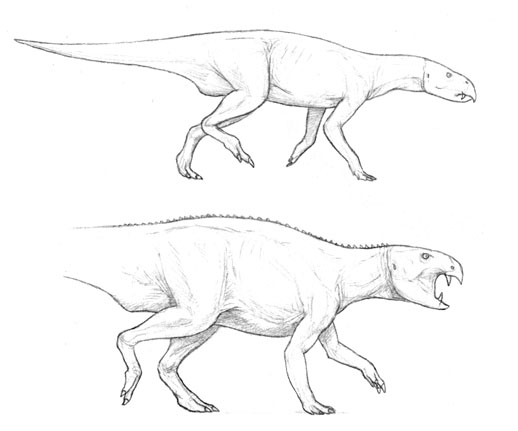
Above: the old restoration of Gryphorhynchus shows it as a sleek predator, not unlike modern rhynchoraptors. Below: the new, more accurate restoration. The tail of the animal is still unknown.
New fossils unearthed from Late Oligocene deposits at Spec-Riversleigh have proven Gryphorynchus, once thought to have been the first rhynchoraptoran predator, to be something else instead. Until now Gryphorhynchus was known from an incomplete skull and some fragmentary limb and pelvic material. Based on the fossils scientists had reconstructed the animal as a sleek and swift predator not unlike the smallest modern rhynchoraptors. It was thought to be closely related to the common ancestor of rhynchoraptors.
The newly found Gryphorhynchus skeleton, nicknamed "Greg", has proven these reconstructions flawed. The new animal that belongs to a new species, Gryphorhynchus robustus, that was closely related to the earlier fossils. It is possible that the bones previously found belonged to a juvenile G. robustus.
"In life Greg was a big and bulky beast and probably not much of a runner. It's more likely that he was an omnivorous scavenger," said Specpaleontologist Kim Xu, who was involved in the excavation of the animal.
Though the otherwise nearly complete skeleton is missing nearly all of the tail, it has become clear that Gryphorynchus was too different from Rhynchoraptors to be closely related to them. "It likely now that the antarctornithopods that gave rise to rhynchoraptors experimented with omnivory and maybe even carnivory several times," Xu said.
"This means the earliest rhynchoraptoran remains are now from the Miocene," said professor Brian Choo, who has been studying fossil rhynchoraptors for years. "But that doesn't necessarily mean they aren't there. We just haven't found them yet," he added. From Spexploration Weekly, November 2003 Issue. - Brian Choo and Daniel Bensen
,=Daspletodontidae=Daspletodon nanus (Anklebiter)
=Rhynchoraptoria=|
| ,=R. diabolus (Jagdpanther) & R. flanneryi (Nashorn)
| ,=Rhynchoraptor=|
| ,=| | ,=R. regius (Greater diamondhide)
| | | `=|
| | | `=R. minimus (Lesser diamondhide)
| | |
| | `=Carnornithopodia ferox (Blacktip)
`=Rhynchoraptoridae=|
`=Sauropanthera rex (Sturmtiger)
Gryphorhynchus robustus (Greg)†
Teratodon maturus (Sabertooth Strumtiger)†


